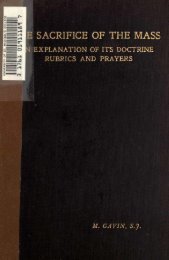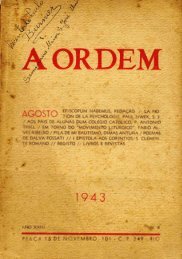E SACRIFICE OF THE MASS
E SACRIFICE OF THE MASS
E SACRIFICE OF THE MASS
Create successful ePaper yourself
Turn your PDF publications into a flip-book with our unique Google optimized e-Paper software.
CHAPTER the NINTH.<br />
<strong>THE</strong> GRADUAL, ALLELUIA, TRACT,<br />
AND SEQUENCE.<br />
<strong>THE</strong> Gradual is called from gradus, a step, because it<br />
was formerly sung as the deacon ascended the steps of<br />
the ambo to chant the Gospel. The Gradual is also<br />
called responsory. The first part was called responsorium<br />
as an answer to the Epistle, the second versus. The<br />
Gradual represents a verse or two of psalms once sung<br />
all through. Sometimes the Gradual is the Church s<br />
own composition and not taken from Scripture, as in the<br />
feast of the Seven Dolours. The first part of the Gradual<br />
in Requiem Masses is also composed by the Church.<br />
The force and meaning of the Gradual is clearly<br />
seen when we remember that the Gradual is closely and<br />
intimately connected with three other portions of the<br />
Mass, the Introit, Offertory, and Communion. (See<br />
the Mass for the First Sunday in Lent, the Mass for<br />
the Holy Innocents and Angel Guardians, the Common<br />
for Bishop and Confessor, &c.) The Introit, Gradual,<br />
Offertory, and Communion are variable and were once<br />
always sung.<br />
The Gradual is seldom said or sung alone. The Alleluia<br />
verse, as it is called, is generally added to the Gradual<br />
throughout the year. This verse consists of two A lleluias,






